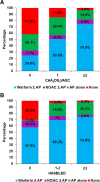Risk profiles and pattern of antithrombotic use in patients with non-valvular atrial fibrillation in Thailand: a multicenter study
- PMID: 30144802
- PMCID: PMC6109333
- DOI: 10.1186/s12872-018-0911-4
Risk profiles and pattern of antithrombotic use in patients with non-valvular atrial fibrillation in Thailand: a multicenter study
Abstract
Background: Anticoagulation therapy is a standard treatment for stroke prevention in patients with non-valvular atrial fibrillation (NVAF) that have risk factors for stroke. However, anticoagulant increases the risk of bleeding, especially in Asians. We aimed to investigate the risk profiles and pattern of antithrombotic use in patients with NVAF in Thailand, and to study the reasons for not using warfarin in this patient population.
Methods: A nationwide multicenter registry of patients with NVAF was created that included data from 24 hospitals located across Thailand. Demographic data, atrial fibrillation-related data, comorbid conditions, use of antithrombotic drugs, and reasons for not using warfarin were collected. Data were recorded in a case record form and then transferred into a web-based system.
Results: A total of 3218 patients were included. Average age was 67.3 ± 11.3 years, and 58.2% were male. Average CHADS2, CHA2DS2-VASc, and HAS-BLED score was 1.8 ± 1.3, 3.0 ± 1.7, and 1.5 ± 1.0, respectively. Antiplatelet was used in 26.5% of patients, whereas anticoagulant was used in 75.3%. The main reasons for not using warfarin in those with CHA2DS2-VASc ≥2 included already taking antiplatelet (26.6%), patient preference (23.1%), and using non-vitamin K antagonist oral anticoagulants (NOACs) (22.7%). Anticoagulant was used in 32.3% of CHA2DS2-VASc 0, 56.8% of CHA2DS2-VASc 1, and 81.6% of CHA2DS2-VASc ≥2. The use of NOACs increased from 1.9% in 2014 to 25.6% in 2017.
Conclusions: Anticoagulation therapy was prescribed in 75.3% of patients with NVAF. Among those receiving anticoagulant, 90.9% used warfarin and 9.1% used NOACs. The use of NOACs increased over time.
Keywords: Antithrombotics; Non-valvular atrial fibrillation; Risk profiles; Thailand.
Conflict of interest statement
Ethics approval and consent to participate
The study protocol was approved by the institutional review boards of all participating hospitals. Written informed consent was obtained from all included patients prior to participation.
Consent for publication
Not applicable.
Competing interests
The authors declare that they have no competing interest.
Publisher’s Note
Springer Nature remains neutral with regard to jurisdictional claims in published maps and institutional affiliations.
Figures
References
-
- Anselmino M, Ferraris F, Cerrato N, Barbero U, Scaglione M, Gaita F. Left persistent superior vena cava and paroxysmal atrial fibrillation: the role of selective radio-frequency transcatheter ablation. J Cardiovasc Med (Hagerstown) 2014;15(8):647–652. doi: 10.2459/JCM.0000000000000144. - DOI - PubMed
-
- Kirchhof P, Benussi S, Kotecha D, Ahlsson A, Atar D, Casadei B, Castella M, Diener HC, Heidbuchel H, Hendriks J, et al. 2016 ESC guidelines for the management of atrial fibrillation developed in collaboration with EACTS. Eur Heart J. 2016;37(38):2893–2962. doi: 10.1093/eurheartj/ehw210. - DOI - PubMed
Publication types
MeSH terms
Substances
LinkOut - more resources
Full Text Sources
Other Literature Sources
Medical


